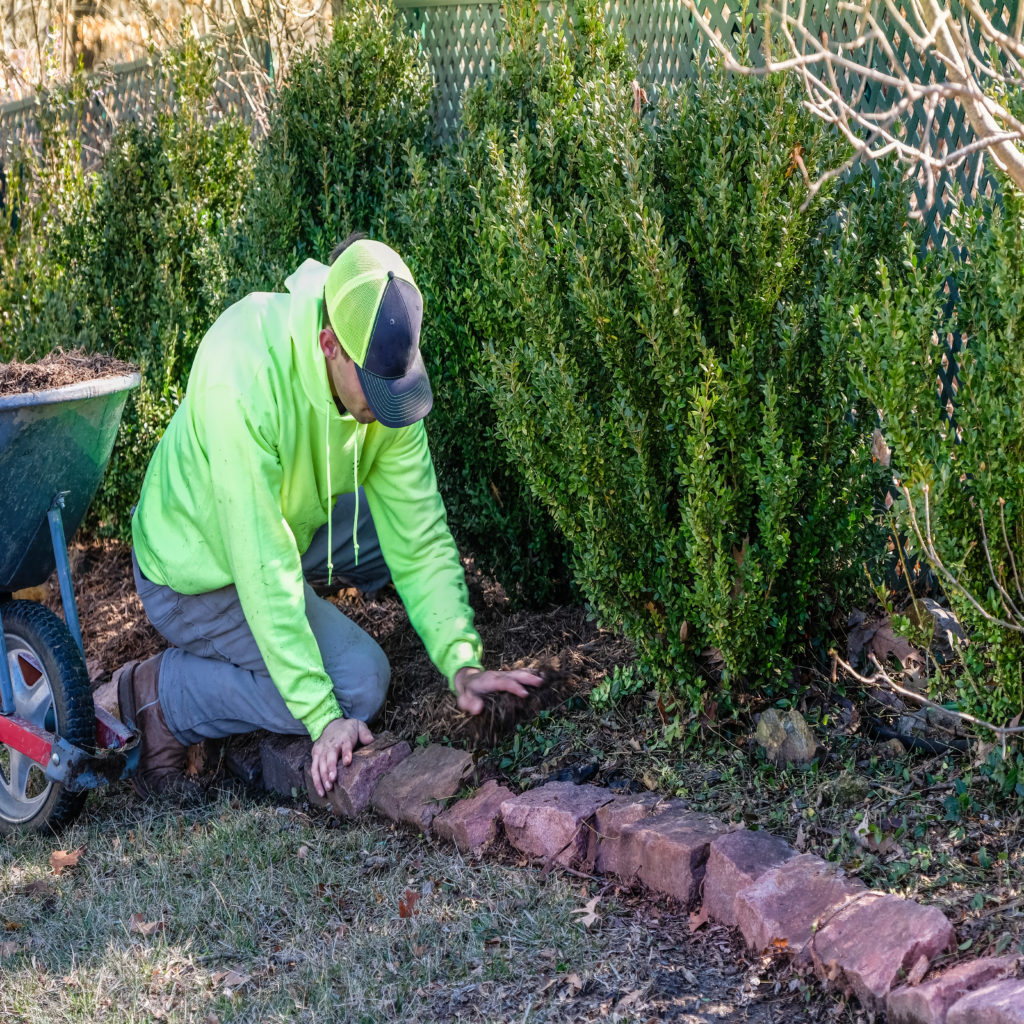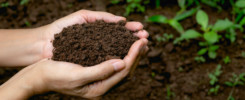
Submitted By: Egan Davis, Principal Instructor (UBC Botanical Garden)
Have you ever been curious about your soil? Soils are teeming with life, physics and chemistry. By understanding a few general principles, you can make informed decisions about the soil in your garden. Soils are the foundation of plants and life on earth. In this article, you will learn about what makes good soil, and why soil health is so important.
What is soil?
From a gardener’s perspective, there are three major types of soils:
- Native soil
- Manufactured soil
- Potting soil
1. Native Soil
Naturally occurring soil is precious. It is a mineral product that has taken thousands of years to break down into small particles of sand, silt and clay. Mixed with decomposed organic materials, these particles bind together to form aggregated structures called peds. Nicely-structured peds are the shape and size of peas (or even grapes). They are finely porous, storing moisture and air. Larger air spaces between peds allow for water, gases and roots to move freely in soil. Native soils provide nutrition and habitat to plants, insects, animals and micro-organisms. As worms and larger animals burrow in soil, layers mix together over time and birds forage in the surface litter. The physical, nutritional and life processes in soil are complex, balanced cycles that are a marvel to study. When significantly disturbed or worked, native soil can easily become damaged and compacted – thus reducing its ability to support life. Gardeners have an important responsibility to respect and preserve native soils.
2. Manufactured Soil
Soil that is sold for landscaping and gardening (otherwise known as manufactured soil) is very different than native soil. In Metro Vancouver, this product will have a sand base that is blended with a composted organic component. The organic materials can include bark, garden waste and animal manures. Manufactured soils tend not to be as physically well-structured compared to native soils. The large size of the undecomposed organic materials improves the porosity of the soil, however, these materials tend to continue to decompose over time. After a few years, the soil is reduced to fine sands that are easily compacted. Water, air and roots cannot move as freely through compacted soil. Plant roots, decomposing leaf litter and compost can build a well-structured, porous soil. This process takes many years, and just like native soils, peds can be easily damaged (returning soil to a compacted state).
3. Potting Soil
Potting soil used in containers is not really soil at all. While soil is mostly a mineral product made of sand, silt and clay, potting soils are mostly made of organic materials such as peat moss, coconut fiber, composts and manures. Typically, the only mineral products found in potting soils are a heat-expanded, ultra-light pumice called perlite. Growing plants in containers is very different than growing plants in the ground. Unlike growing plants in the ground, when a container is watered, the potting soil becomes saturated and then it drains. Soil in the ground rarely becomes saturated. When it does, it turns to mud and is very badly damaged. Knowing this, it is easy to understand why it is best to use potting soil when growing plants in containers, rather than soil from the ground. Potting mixes are designed to be really porous as water must be able to infiltrate a potting mix and percolate through the depth of the pot quickly. Also, after watering a plant in a container, enough of the water has to drain away to leave sufficient air space in the potting soil for the roots to be healthy. Potting soils are often sterile and low in nutrition so – some type of fertilizer usually needs to be added. Potting soil materials break down over time and the porosity will slowly be reduced. This tendency (combined with plants becoming root bound over time) makes it necessary to repot plants, and replace or amend potting soils every few years.
Soils in Urban Gardens
Soil conditions in urban gardens are usually quite poor. Unless bordering a natural area, an urban site will likely have had any native soils removed. Before an urban garden or lawn is installed, the poor-quality construction soils are made level, and a shallow layer of manufactured topsoil is installed over top. As the installed topsoil decomposes and compresses, this layer becomes even shallower. This is a common challenge for urban gardeners left with a thin bed of fine sandy soil layered over compacted construction soils. The result is shallow-rooted plants growing in soil that dries out quickly and becomes easily compacted. Adding annual mulches of leaves, compost or other organic material is the easiest way to slowly remedy this situation.

Understanding Soil Quality
Water, Air and Roots
The physical qualities of soil influence the ability of water, air and roots to move easily through the soil profile. A good garden soil should have about 50 % pore space, with the rest being solid particles. A well-aerated and non-compacted soil like this supports a healthy ecosystem and creates ideal conditions for plant roots, worms, insects and microbes.
Nutrition
The soil chemistry associated with plant nutrition can be a bit of a worm hole to explore. If this interests you then don’t hesitate to learn as much as you can. If chemistry is not a passion though, you can assess the general nutritional qualities of soil without getting too overwhelmed. In fact, it can be a little dangerous to start dabbling with fertilizers and soil chemistry. A much more stable approach to supplying plant nutrition is to embrace natural systems of nutrient cycling rather than supplementing with manufactured fertilizers.
Observe how nutrients are cycled in a natural system. It is the key process for all life on Earth. Through photosynthesis, plants pull carbon from the air and hydrogen from water and make their own carbohydrates (sugars). Nutrients in the soil are required to help all of a plant’s parts to function, and to support photosynthesis. These nutrients are drawn from the soil through roots and with carbon, become part of plant tissues. As plant tissues complete their cycle and decay, microbes break them down which returns these materials to the soil and air. The carbon and water is recycled, and the nutrients are recycled too – it is a beautiful cycle. This system can be mimicked in the garden through composting and mulching practices. The benefits of this approach tend to be stable and longer lasting; for instance, nutrients that are already in the soil become more available to plants. Conversely, correcting nutritional issues by fertilizing soils with manufactured products is often a short-term solution.

One thing to keep in mind is that it is a mistake to think that all plants require peak nutritional levels. Many plants thrive in the lean soils that they are adapted to. When selecting plants for a site, it is a far better approach to match plants to the existing soil rather than making great efforts to change the soil (or even worse, remove and replace it with new soil).
Biological Health
Soil provides a habitat for an enormously broad range of organisms. Plants, insects, worms, mammals, birds, reptiles, amphibians, fungi, bacteria and other micro-organisms live and feed in soil. All of this life is interconnected in the soil matrix as part of a complex and multi-layered food chain. All of these interactions facilitate healthy plant growth through nutrient cycling and soil mixing. The health of any one of the biological elements in this system has a rippling effect through the entire food chain. For example, bacteria that decompose organic materials and make nutrients available to plants require well-aerated, porous soils for oxygen and water. All of the physical, chemical and biological factors contributing towards good soil health are interconnected and interdependent. It is a beautiful and harmonious balance.



